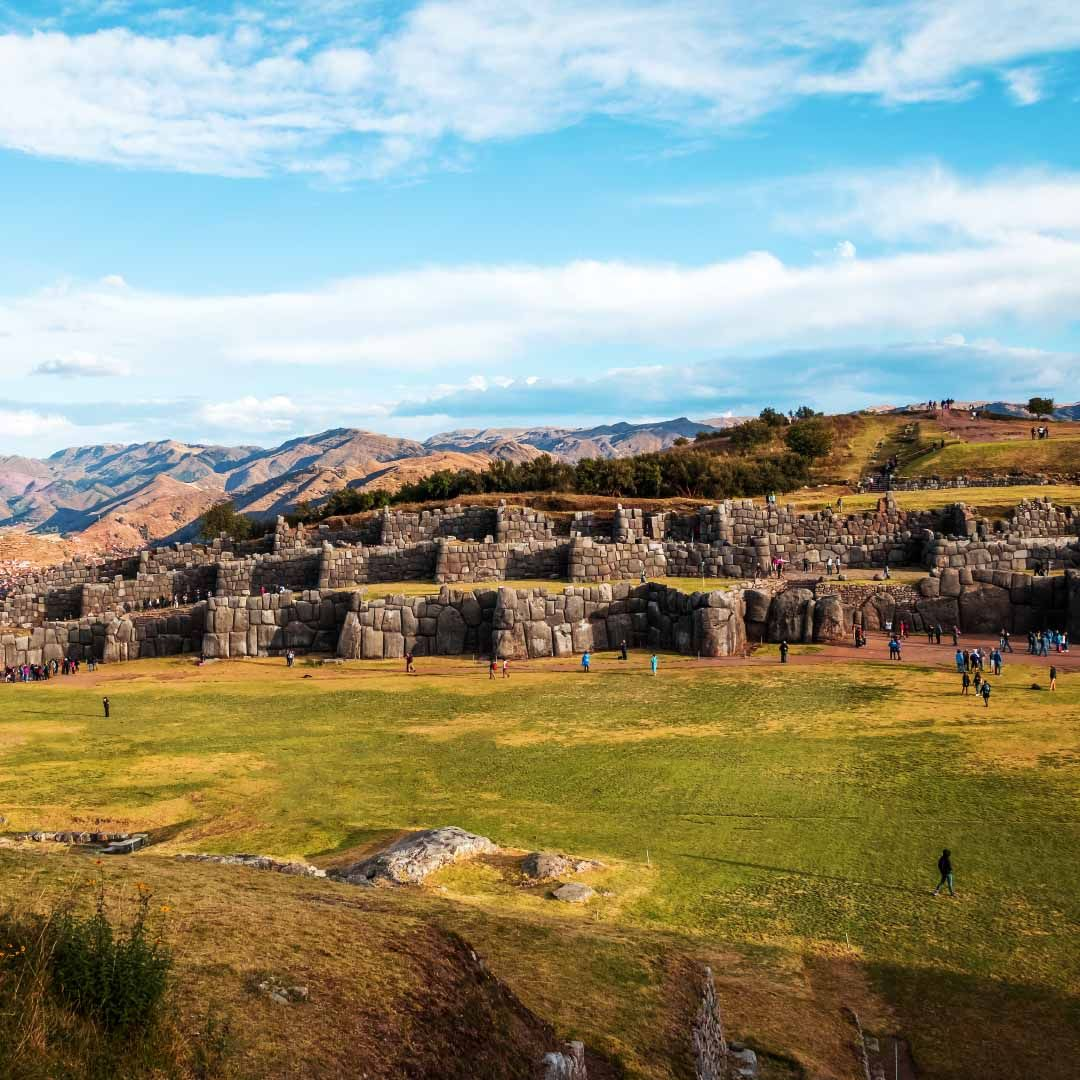Embark on a captivating journey through the heart of Peru's ancient wonders as we unveil the marvels of Inca culture. From the mystical citadel of Machu Picchu to the towering stone walls of Sacsayhuaman, this comprehensive guide invites you to explore the rich tapestry of Inca history, architecture, and traditions. Immerse yourself in the fascinating tales of the Incas, a civilization that left an indelible mark on the Andean landscape.
Whether you're a history enthusiast, a curious traveler, or someone seeking the allure of ancient mysteries, this guide promises to unravel the secrets and wonders that define the extraordinary legacy of the Inca civilization.
Join us on this immersive odyssey, where each page is a step back in time, inviting you to witness the enduring splendor of Peru's Inca heritage.
What will you find here?
- The Inca Culture: Unraveling the Marvels of Inca civilization
- Inca Culture art: Masterpieces beyond time - A glimpse into Inca artistry
- A culinary odyssey - Savoring the flavors of Inca gastronomy
- Triumphs and legacies - Inca Culture's greatest achievements
- Facts about the Inca Culture: Religion and traditions
- Living Heritage - Inca Influences in modern times
- Aztec and Inca culture: A tale of two civilizations - Contrasts and parallels
- Peruvian Pre-Inca cultures: Paving the way - An insight into cultures before the Incas
The Inca Culture: Unraveling the Marvels of Inca civilization
Embark on a journey into the fascinating realm of the Inca civilization, a cultural tapestry woven with innovation, engineering marvels, and spiritual depth. Iconic sites like Machu Picchu stand as testaments to the Inca's remarkable engineering prowess and celestial alignment. Sacsayhuaman, the monumental fortress overlooking Cusco, reveals the intricacies of their stone-cutting expertise.
While the Nazca Lines, etched into the Nazca Desert, are attributed to the Nazca culture predating the Inca civilization, Peru's landscape is adorned with the Inca's imprint. Explore the agricultural terraces of Moray and the awe-inspiring Sacred Valley, witnessing a civilization that harmonized with nature, leaving behind a legacy that continues to captivate and inspire.
As we navigate the captivating realms of the Inca culture, it's an exploration of a civilization that seamlessly blended innovation, spirituality, and a deep understanding of their surroundings. The Inca's influence on Peru's landscape is a compelling narrative, inviting you to unravel the layers of a culture that flourished in the heart of the Andes.

Inca Culture art: Masterpieces beyond time - A glimpse into Inca artistry
Immerse yourself in the enduring legacy of Inca artistry, where masterpieces transcend the constraints of time, offering a captivating glimpse into civilization's creativity. The Inca people, known for their architectural marvels, also expressed their artistic prowess through intricate pottery, textiles, and metalwork. Delicate textiles adorned with vibrant patterns, skilled metalwork showcasing intricate designs, and finely crafted ceramics tell stories of a society that valued both functionality and aesthetic appeal.
The precision in their artistic expressions reflects not only technical expertise but also a deep connection to the cultural and spiritual dimensions of Inca life. These artifacts, ranging from ceremonial textiles to ceremonial gold and silver pieces, provide a tangible connection to the artistic brilliance that flourished in the heart of the Andes.
As we explore Inca Culture Art, it's a journey into a world where every artifact whispers tales of a civilization's artistic ingenuity. The rich tapestry of Inca artistry, from the intricacies of their metalwork to the vibrant hues woven into textiles, stands as a testament to their cultural sophistication. Beyond the stone walls of Machu Picchu, this art offers a window into the soul of a civilization that elevated craftsmanship to an art form, leaving behind a visual legacy that continues to awe and inspire.

Recuperado de: Museo Larco
A culinary odyssey - Savoring the flavors of Inca gastronomy
Embark on a tantalizing culinary journey through the tastes of Inca gastronomy, where each dish unveils a story of ancient traditions and culinary innovation. Inca cuisine, rooted in the abundance of the Andean region, offers a diverse palate that mirrors the rich agricultural practices of the time.
- Quinoa delights: Quinoa, revered as the "mother grain" by the Incas, takes center stage in various dishes. From hearty soups to nutrient-packed stews, quinoa showcases its versatility and nutritional prowess.
- Potent Pachamanca: Pachamanca, a traditional Inca cooking method, involves burying ingredients like meats, potatoes, and corn with hot stones underground. The result is a succulent, earthy feast that pays homage to the Andean landscape.
- Chicha - The Inca beverage: Chicha, a fermented maize beverage, is a staple in Inca gastronomy. Whether plain or flavored with fruits and spices, chicha adds a refreshing touch to the culinary tapestry.
- Amaranth elixirs: Amaranth, another revered grain, finds its way into Inca gastronomy in the form of invigorating beverages. Amaranth elixirs offer a nutrient-packed, energy-boosting experience.
Savoring the flavors of Inca gastronomy is not just a culinary adventure; it's a cultural exploration that transports taste buds to the heart of an ancient civilization. From the heights of the Andes to the depths of traditional cooking methods, Inca cuisine presents a feast that celebrates the union of history, agriculture, and gastronomic artistry.

Recuperado de: Revista Andina
Triumphs and legacies - Inca Culture's greatest achievements
The Inca culture stands as a testament to remarkable achievements that have left an indelible mark on history. Among its triumphs, the architectural marvel of Machu Picchu stands out as an awe-inspiring testament to Inca engineering and celestial alignment. Built atop the Andes, this citadel not only showcases their advanced construction techniques but also serves as a symbol of their spiritual connection to the cosmos.
In addition to their architectural feats, the Inca's mastery of agricultural innovation is a lasting legacy. The creation of terraced fields and agricultural experiments in Moray reflect a profound understanding of the land and its resources. The intricate network of roads, including the renowned Inca Trail, is another enduring achievement that facilitated communication, trade, and cultural exchange across the vast Inca Empire. These triumphs and legacies underscore the ingenuity and organizational prowess of a civilization that flourished in the heart of the Andes, shaping the course of history and leaving an unparalleled cultural legacy.

Facts about the Inca Culture: Religion and traditions
Explore the profound religious and cultural dimensions of the Inca civilization through these enlightening facts:
- Inti worship: Central to Inca religious practices was the veneration of Inti, the sun god. Inca rulers claimed divine descent from Inti, emphasizing the spiritual connection between the ruling elite and the celestial forces governing life.
- Coricancha Temple: The Coricancha, or "Golden Temple," in Cusco was a sacred site dedicated to Inti. This architectural masterpiece exemplifies the Inca's advanced construction skills and the grandeur associated with their religious edifices.
- Intihuatana stone: An integral part of Inca rituals, the Intihuatana stone served as an astronomical observatory. This ritual stone, associated with the sun's position during solstices, showcased the Inca's sophisticated understanding of celestial movements.
- Pachamama Reverence: Inca traditions were deeply rooted in a harmonious relationship with nature. The reverence for Pachamama, the earth goddess, was manifested in rituals, ceremonies, and daily life practices, emphasizing the interconnectedness of humanity and the environment.
These facts offer a glimpse into the spiritual depth and cultural richness of the Inca civilization, where religion and traditions were interwoven into the very fabric of daily existence.

Living Heritage - Inca Influences in modern times
The enduring legacy of the Inca civilization extends beyond ancient ruins, weaving its way into the fabric of modern Peruvian life. In contemporary society, Inca influences are prominently showcased in art, architecture, and cultural practices. The vibrant markets of Cusco, with their colorful textiles and intricate
handicrafts, pay homage to the Inca's artistic mastery, creating a living testament to the enduring craftsmanship of the past.
Modern Peruvian traditions also echo the echoes of Inca heritage, particularly in agricultural practices and communal celebrations. The continued reverence for Inti, the sun god, is evident in festivals like Inti Raymi, a spectacular reenactment of Inca rituals that draws locals and visitors alike. The fusion of ancient traditions with contemporary life showcases the resilience and vibrancy of the Inca's cultural influence, fostering a connection between the past and present that is palpable in the bustling streets and cultural events of Peru.

Aztec and Inca culture: A tale of two civilizations - Contrasts and parallels
Explore the captivating narratives of the Aztec and Inca civilizations, two monumental pillars of pre-Columbian America, through this succinct comparison:
|
Aspect
|
Aztec culture
|
Inca culture
|
|
Geographical scope
|
Centered in Mesoamerica, with the capital city of Tenochtitlan (present-day Mexico City).
|
Thrived in the Andean region, with Cusco as the heart of the Inca Empire.
|
|
Social organization
|
Structured as a city-state with a complex social hierarchy, including powerful priests and warriors.
|
Organized as a vast empire with an emperor at the helm, supported by a highly organized administrative system.
|
|
Agricultural practices
|
Engaged in advanced farming techniques, including chinampas (floating gardens), to sustain a large population.
|
Mastered terrace farming to cultivate crops at varying altitudes, showcasing adaptability to diverse landscapes.
|
|
Religious beliefs
|
Revered a pantheon of gods, with a particular focus on Huitzilopochtli (sun and war god) and Quetzalcoatl (feathered serpent god).
|
Worshiped Inti, the sun god, and revered nature deities, emphasizing a spiritual connection with the environment.
|
|
Architectural marvels
|
Constructed grand temples, pyramids, and ceremonial ball courts, with the Templo Mayor being a prominent religious center.
|
Showcased extraordinary stone-cutting skills, evident in architectural wonders like Machu Picchu and the intricate stonework of Sacsayhuaman.
|
This comparative glimpse highlights the distinct characteristics and shared elements that define the rich tapestries of Aztec and Inca cultures, offering a nuanced understanding of their parallel yet unique contributions to the mosaic of ancient civilizations.

Peruvian Pre-Inca cultures: Paving the way - An insight into cultures before the Incas
Discover the diverse pre-Inca cultures that shaped Peru's early history through a concise comparison:
|
Culture
|
Chavín civilization
|
Tiwanaku culture
|
Wari civilization
|
Chimú civilization
|
|
Time period
|
Flourished from 900 BC to 200 BC.
|
Thrived from 200 AD to 1000 AD.
|
Rose to prominence around 600 AD.
|
Flourished from 900 AD to 1470 AD.
|
|
Artistic achievements
|
Known for monumental architecture, intricate stone carvings, and the iconic Lanzón monolith.
|
Renowned for monumental structures like the Gate of the Sun, advanced metalworking, and pottery.
|
Displayed advanced urban planning, monumental constructions, and vibrant ceramics.
|
Showcased exceptional metalwork, intricate textiles, and distinctive pottery styles.
|
|
Religious significance
|
Revered a central deity, as evidenced by the Chavín de Huántar complex, suggesting a religious center.
|
Centered around spiritual beliefs, with intricate carvings and statues depicting mythological figures.
|
Featured religious centers like Pikillacta, suggest a complex religious structure.
|
Exhibited a powerful religious cult, evident in the adobe city of Chan Chan and the Temple of the Moon.
|
|
Architectural feats
|
Showcased advanced construction techniques in the underground galleries of Chavín de Huántar.
|
Constructed expansive platforms and raised fields, displaying engineering prowess.
|
Developed large urban centers with complex infrastructure and monumental architecture.
|
Created intricate adobe cities, with Chan Chan being the largest pre-Columbian city in South America.
|
These pre-Inca cultures, spanning different regions and periods, collectively paved the way for the Inca Empire, leaving behind a rich legacy of art, architecture, and societal advancements in the diverse landscapes of ancient Peru.











